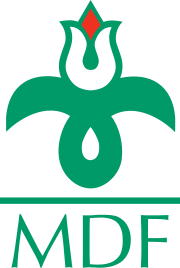
Back Венгерскі дэмакратычны форум Byelorussian Унгарски демократичен форум Bulgarian Fòrum Democràtic Hongarès Catalan Maďarské demokratické fórum Czech Magyar Demokrata Fórum German Foro Democrático de Hungría Spanish Unkarin demokraattinen foorumi Finnish Forum démocrate hongrois French Magyar Demokrata Fórum Hungarian Forum Democratico Ungherese Italian
Hungarian Democratic Forum Magyar Demokrata Fórum | |
|---|---|
 | |
| First leader | Zoltán Bíró |
| Last leader | Zsolt Makay |
| Founded | 27 September 1987 |
| Dissolved | 8 April 2011 |
| Succeeded by | Democratic Community of Welfare and Freedom (JESZ) |
| Headquarters | 1025 Budapest, Szilágyi Erzsébet fasor 73. |
| Newspaper | Magyar Fórum (1988–1993) |
| Youth wing | Youth Democratic Forum |
| Ideology | |
| Political position | Centre-right[1][7][9] |
| European affiliation |
|
| European Parliament group |
|
| International affiliation | Centrist Democrat International |
| Colours | Green |
| Website | |
| mdf.hu | |
The Hungarian Democratic Forum (Hungarian: Magyar Demokrata Fórum, MDF) was a centre-right political party in Hungary. It had a Hungarian nationalist, national-conservative, Christian-democratic ideology. The party was represented continuously in the National Assembly from the restoration of democracy in 1990 until 2010. It was dissolved on 8 April 2011.
The MDF was the largest party on Hungary's emergence as a democratic country under the leadership of József Antall, Prime Minister between 1990 and 1993. Since then, its representation receded, with the party playing the role of junior coalition partner to Fidesz from 1998 to 2002, and in opposition otherwise.
It was a member of the Centrist Democrat International and was a member of the European People's Party until 2009, when it joined the Alliance of European Conservatives and Reformists. The MDF's first MEP, Péter Olajos, was a member of the European People's Party–European Democrats group from 2004 to 2009, while Lajos Bokros sat with the European Conservatives and Reformists from 2009 in the European Parliament.
- ^ a b Calvocoressi, Peter (2001), World Politics, 1945-2000 (Eighth ed.), Pearson Education, p. 323
- ^ a b Szarvas, Lászlo (1995), "Parties and Party Factions in the Hungarian Parliament", Hungary, Frank Cass & Co., pp. 121–122
- ^ Spirova, Maria (2007), Political Parties in Post-Communist Societies: Formation, Persistence, and Change, Palgrave Macmillan, p. 61
- ^ Janusz Bugajski (1995). Ethnic Politics in Eastern Europe: A Guide to Nationality Policies, Organizations, and Parties. M.E. Sharpe. pp. 462–. ISBN 978-0-7656-1911-2.
- ^ Bakke, Elisabeth (2010), "Central and East European party systems since 1989", Central and Southeast European Politics Since 1989, Cambridge University Press, p. 80
- ^ Hloušek, Vít; Kopeček, Lubomír (2010), Origin, Ideology and Transformation of Political Parties: East-Central and Western Europe Compared, Ashgate, p. 115
- ^ a b Hanley, Seán (2006), "Getting the Right Right: Redefining the Centre-Right in Post-Communist Europe", Centre-Right Parties in Post-Communist East-Central Europe, Routledge, p. 21
- ^ Renwick, Alan (2002), "The Role of Non-Elite Forces in Hungary's Negotiated Revolution", The Roundtable Talks of 1989: The Genesis of Hungarian Democracy, Central European University Press, p. 195
- ^ Jeffries, Ian (2002), Eastern Europe at the Turn of the Twenty-First Century: A Guide to the Economies in Transition, Routledge, p. 212
© MMXXIII Rich X Search. We shall prevail. All rights reserved. Rich X Search